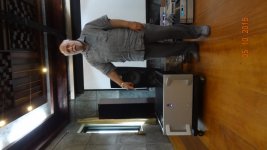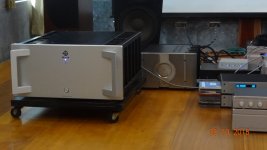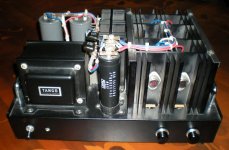~50 year old power transistors, a DIY museum ?
(care for a glimpse of a page in a NEC databook)
No it`s not some aparatus from museum , but actual DIY creation from far Japan , where even today Japanese DIY people use those rare vintage parts to made power amps following that very specific retro style ,
No PCB`s use (or very little use of them) , everything is connected using PTP (point to point) technique ,
Actually I think that those amps are mechanically designed as some old tube amps , but instead of tubes , tube sockets , we can see vertically stacked heatsinks , main transf. , and filter caps ,
all in all it is my favorite DIY style , easy for assembling and connection and very easy for maintenance and eventual repair ,
and the best thing is that I can`t see nowhere those fancy ugly LCD function front panels with blue LED back illumination . 🙂
Attachments
No one is saying (or at least I'm not saying) that copper is better per se. But make it thick enough and the low frequency cutoff improves, ditto with Al or Ag. What one does lose are saturation effects with wonderful substances like mu metal.Copper would be even worse at low frequencies. The only way copper provides any significant magnetic field shielding is at higher frequencies due to eddy current losses from skin effect.
If you don't understand it, then go to Magnetic Shield Corp's website and show me their copper shielding that you guys are claiming is better than high permeability ferromagnetic materials. Go on, show me. If copper is better, these people should know. Maybe you can email them and set them straight on the matter as they've obviously been doing it wrong all these years.
ae
When Aguiar engineered the Ap AUX-0025, Hofer thought the case would be steel, and Duke cautioned that the steel would cause distortion. He was right, and the case is Al.
I hope there are some good gate stoppers with those FETs.No it`s not some aparatus from museum , but actual DIY creation from far Japan , where even today Japanese DIY people use those rare vintage parts to made power amps following that very specific retro style ,
No PCB`s use (or very little use of them) , everything is connected using PTP (point to point) technique ,
Actually I think that those amps are mechanically designed as some old tube amps , but instead of tubes , tube sockets , we can see vertically stacked heatsinks , main transf. , and filter caps ,
all in all it is my favorite DIY style , easy for assembling and connection and very easy for maintenance and eventual repair ,
and the best thing is that I can`t see nowhere those fancy ugly LCD function front panels with blue LED back illumination . 🙂
We're talking about shielding against magnetic fields. And absorption loss is the primary mechanism here. That's really the only way materials like copper can provide any real shielding at all of magnetic fields. It is the absorption loss due to skin effect that copper can be effective at higher frequencies.
se
You were doing fine up until that last sentence.
THx-RNMarsh
Gentle men;
Now here you have my version of wretched excess. But that is about right for me. Each mono-block weights in at around 550 pounds ! Huge C-core transformer. CFA design (of course). >450v/usec. Distortion? What distortion? Power output? Cost? Don't ask. Yes, thats a class-A N.Pass amp dwarfed in the background.... and you thought That was a big size amp. These are in the listening room of Dr Kung down in Trang, Thailand (near the Malasia border).


Well, someone had to do it.
THx-RNMarsh
Now here you have my version of wretched excess. But that is about right for me. Each mono-block weights in at around 550 pounds ! Huge C-core transformer. CFA design (of course). >450v/usec. Distortion? What distortion? Power output? Cost? Don't ask. Yes, thats a class-A N.Pass amp dwarfed in the background.... and you thought That was a big size amp. These are in the listening room of Dr Kung down in Trang, Thailand (near the Malasia border).


Well, someone had to do it.
THx-RNMarsh
Last edited:
Those are still pretty nice headphones IMO, although I am not a headphone connoisseur. I am looking forward to auditioning Alex Rosson's top-of-the-line, and he just loaned a pair to my friend so he could evaluate them (although he has now parted ways with Audeze). Alex told me he started doing planar magnetics for loudspeaker line arrays, but moved into his acclaimed headphones after the arrays didn't look to be a winning strategy for sales.All three amigos have a K1000 as reference.
A former friend (just one too many egregious slights and offenses over many years) used to have a prototypical exchange in which he would deride me for failing to do something or other, often knowing that it was a significant expense (for him he would just call his rich mother and beg, and she'd send a check). He touted the K1000 phones and said, as an apartment dweller, he simply couldn't understand why I didn't get a pair, and went on to mention that a retailer had a couple of show samples at a substantial discount. I said (for a change) Alden, you're right. I'm going to order a pair. Long silence on the line.
Well errrr if you call them tell them I am about to order a pair. I said (with clear intent of instilling paranoia, I confess) What if I get the last pair?
I had been loaned his Roland electronic harpsichord, and was told I could buy it from him. So towards that purchase I bought both show sample pairs of K1000 and told him I would send him his.
This evoked a storm of dismay, tax records/expenses no no no this shall not stand. So I called the retailer and said Sorry, etc. and just got the one pair for myself.
Eventually he reneged on the harpsichord and had to have it back. Of course by then they were no longer available. I considered disassembling it and sending it back as a kit, part by part

But you could achieve the same thing with a lot thinner steel chassis.
se
I understand and agree, but my points were raised in support of Brad's original point that a solid hewn chassis made out of Cu would have pretty darn good magnetic shielding as well. The fact that such a proposal was patently ridiculous and a waste of material was, well, immaterial to the discussion. 😀
The high-end ($$-wise, at least) of audio has spoken and they like their massive chassis--might as well get take advantage of the aesthetic in an attempt to benefit other aspects, no?
And a hogged out silver chassis could always be gutted and melted down, if one needed money 😀I understand and agree, but my points were raised in support of Brad's original point that a solid hewn chassis made out of Cu would have pretty darn good magnetic shielding as well. The fact that such a proposal was patently ridiculous and a waste of material was, well, immaterial to the discussion. 😀
The high-end ($$-wise, at least) of audio has spoken and they like their massive chassis--might as well get take advantage of the aesthetic in an attempt to benefit other aspects, no?
Beware, some french members are reading this forum. Already that is hard to forget the Jeanne d'Arc's death.Concorde was machined out of solid money! Expensive, noisy, inefficient but I still miss it flying over the house.
It was probably trying the K1000s that lead me (many years later) to my ESP/950s. Must get them fixed.
Beware, some french members are reading this forum. Already that is hard to forget the Jeanne d'Arc's death.
Oh you can't take all the blame for it being decommissioned 😛
Gentle
Way to go, Mr. Marsh.
(that edge trim looks very attractive, plus highly practical)
I love how you dressed to match the amps.
Like those socks?
Well, it's Asia, you know.
-RNM
It is inelegant to deliver such a monster amp in the morning wearing a smoking.I love how you dressed to match the amps.
(And never let to your client a chance to think the item he bought was overpriced ;-)
Last edited:
How much can you bring in your Rolls Royce ?But how many burly men were required to lift it off the delivery dolly?
Richard, I love your logo on the amp !
It is inelegant to deliver such a monster amp in the morning wearing a smoking.
(And never let to your client a chance to think the item he bought was overpriced ;-)
Actually he's the Prez of the company who built the beasts. So he paid cost only. How much is OEM cost? Don't ask.
-RNM
Last edited:
How much can you bring in your Rolls Royce ?
Richard, I love your logo on the amp !
I dont know about a RR but two could probably fit in the trunk of a Bentley. .... with block and tackle.
The logo is actually from a petroglyph found near my home by a small river but well hidden in the mountainous area.
-RNM
But how many burly men were required to lift it off the delivery dolly?
I avoided being around when they had to move it to the room. But I was told 5 men. Even so, thats a heavy lift --- >100 pounds per man. Check with your insurance company if your floor is then covered in your policy.
-RNM
- Status
- Not open for further replies.
- Home
- Member Areas
- The Lounge
- John Curl's Blowtorch preamplifier part II
